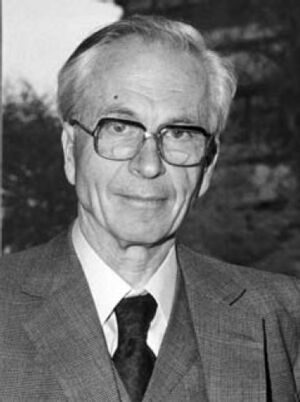John Argyris (nonfiction)
Johann (John) Hadji Argyris FRS (Greek: Ιωάννης Χατζι Αργύρης; 19 August 1913 – 2 April 2004) was a Greek pioneer of computer applications in science and engineering, among the creators of the finite element method (FEM), and lately Professor at the University of Stuttgart and Director of the Institute for Statics and Dynamics of Aerospace Structures.
Career
His first job was at the Gollnow company in Stettin, where he was involved among other things in high radio transmitter masts. In 1943, he joined the research department of the Royal Aeronautical Society in England. Starting from 1949 he was lecturer in aeronautical engineering at the Imperial College London of the University of London, where he assumed a chair in 1955.
In 1959, Argyris was appointed a professor at the Technical University of Stuttgart (today University of Stuttgart) and director of the Institute for Statics and Dynamics of Aerospace Structures. He created the Aeronautical and Astronautical Campus of the University of Stuttgart as focal point for applications of digital computers and electronics.
Argyris was involved in and developed to a large extent the Finite Element Method along with Ray William Clough and Olgierd Zienkiewicz after an early mathematical pre-working of Richard Courant.
His nomination as a Fellow of the Royal Society in March 1986 reads:
Professor Argyris commenced his scientific career at Imperial College in 1949 and subsequently accepted in 1959 a joint appointment as Professor at Imperial College and Professor and Director of the Institute of Astronautical Structures at Stuttgart. Professor Argyris pioneered in the United Kingdom and Europe computer mechanics and established in the early 50's the matrix structural theory introducing the first finite elements concepts including effects of material and geometrical nonlinearities. This work initiated an explosive development of computational mechanics which is still an expanding area. In this field he continued without interruption as one of the leading figures and published a prodigious number of papers (over 300) ranging in applications from structural problems through fluid mechanics, lubrication, celestial mechanics. The computer system ASKA developed under his direction was the model for many subsequent industrial developments. Professor Argyris has been honoured abroad by a great number of distinctions including the Theodore von Karman Medal, Timoshenko Mecal [sic] (ASME), I. B. Laskowitz Gold Medal in Astronautics (N.Y. Acad. Of Sc.) and Copernicus Medal (Polish Acad. Of Sc.).
Personal life
His uncle, Constantin Carathéodory, was a Greek mathematician of the Modern Era. He died in Stuttgart and is buried in the Sankt Jörgens Cemetery in the city of Varberg, Sweden.
In the News
Fiction cross-reference
Nonfiction cross-reference
- Ray William Clough (nonfiction)
- Richard Courant (nonfiction)
- Finite element method (nonfiction)
- Mathematician (nonfiction)
- Mathematics (nonfiction)
- Olgierd Zienkiewicz (nonfiction)
External links:
- John Argyris @ Wikipedia
